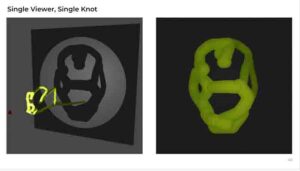- Many of us have attempted to create abstract shapes with our hands to cast shadows on a wall which resemble a bird or an aeroplane
- In their research, they have focussed on creating 3D structures using a technique called differentiable rendering, which is used in computer graphics
- This research has potential applications in art installations, making it possible to create intricate shadow art for galleries and public spaces
NE EDUCATION BUREAU
GANDHINAGAR, JULY 14
Adding another feather to the Institute’s cap, a group of researchers at the Indian Institute of Technology Gandhinagar (IITGN) have come up with a fascinating research, drawing from the concept of shadow art.

Many of us have attempted to create abstract shapes with our hands to cast shadows on a wall which resemble a bird or an aeroplane. Now, when you look at the hand, the abstract shape of the fingers contorted in a jumbled fashion does not appear to be meaningful, but the cast shadow does form a recognisable shape. This intriguing and magical world of creating 2D shadows using 3D shapes is called shadow art.
A team of researchers from IIT Gandhinagar has explored the same concept in their recent work and they have taken it a step further. In their research, they have focussed on creating 3D structures using a technique called differentiable rendering, which is used in computer graphics. As part of the research, the IITGN team focussed on finding 3D knot-based tubular structures which resemble particular target images when viewed from a specific viewpoint.
The novelty of IITGN teams’ research lies in the fact that they have aimed to create physically-realisable models using differentiable rendering. This makes it suitable for real-world applications. For instance, their work can be used to create and install 3D art sculptures in an art gallery. This research has potential applications in art installations, making it possible to create intricate shadow art for galleries and public spaces.
Their research was inspired by the artwork of Larry Kagan- the American sculptor who uses steel wires, a wall, and a light source to create stunning works of shadow art. At first glance, his artwork simply appears to be a mess of wires, but when light shines on the installations, the resulting shadows take intricate shapes, such as the image of Che Guevara or a man dribbling a basketball.
For the purpose of their research, the IITGN team has considered a specific form of structure called knots. A knot is a closed loop in three-dimensional space such that its initial point and final point are the same. When a sphere is moved along such a knot, a tubular structure is formed. The researchers have used this specific form of structure, tubular knots, in their research.
To showcase the applicability of their work, the researchers also created a real-world demonstration. For this, they 3D printed the tubular structure generated through differentiable rendering for a particular desired image (smiley) and then cast a shadow on the wall and also showed it through the specific viewpoint to reveal the target image.
According to the researchers, some of the practical applications of this research can be found in the artistic domain. Artists might use these insights to create unique art installations. For example, a small miniature sculpture in an art gallery could be designed so that, when illuminated, it casts intricate and meaningful shadows. This work can also be used to explore innovative storytelling methods and make learning more creative at various levels of education. On a broader scale, an artist could construct a massive structure that, when viewed from a particular point, aligns to reveal a specific image or form. These applications show how differential rendering can be used for artistic expression, which can be further enhanced through the manipulation of light, shadows, and perspective. This will offer the viewers an engaging and dynamic visual experience.












